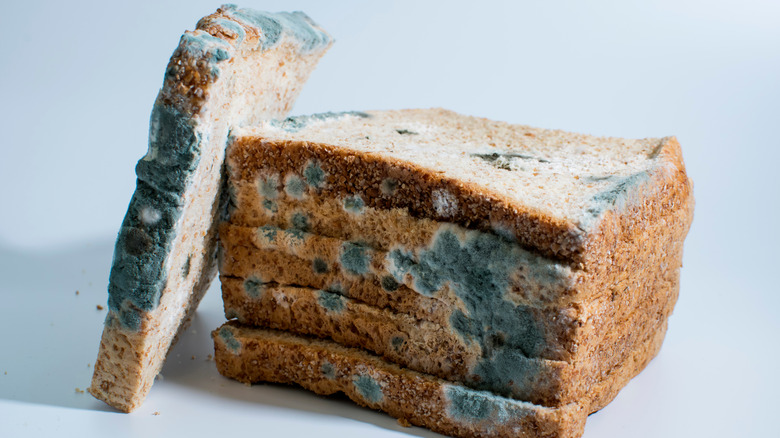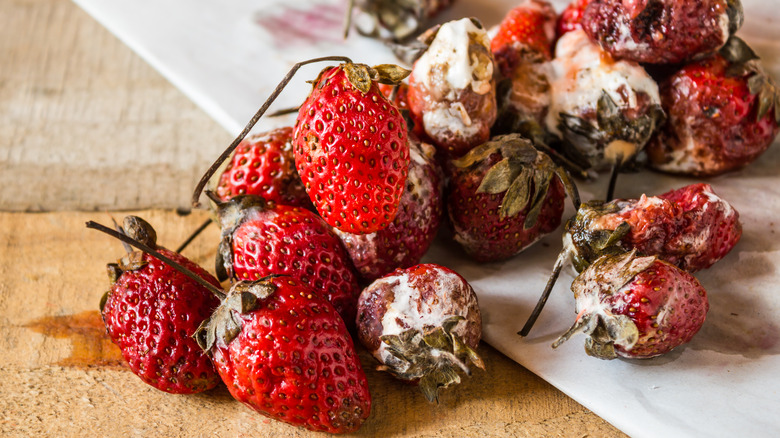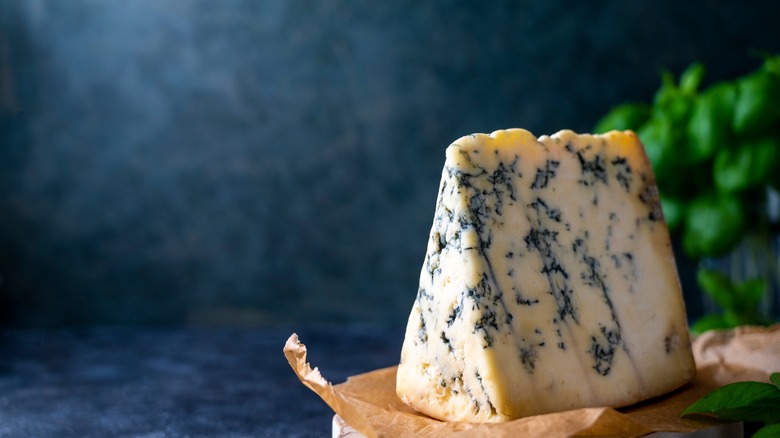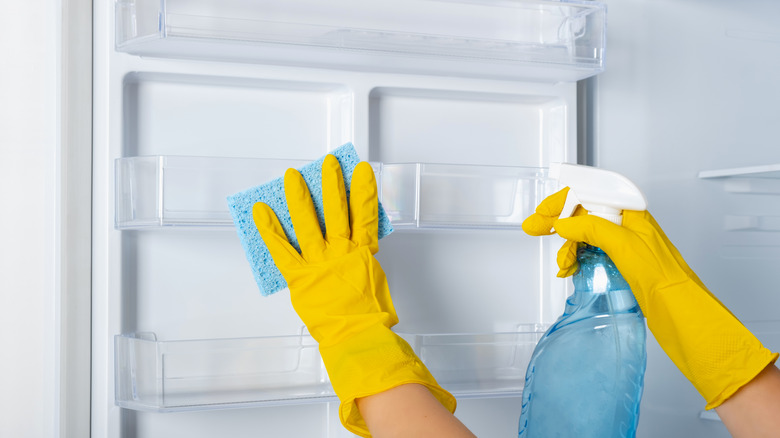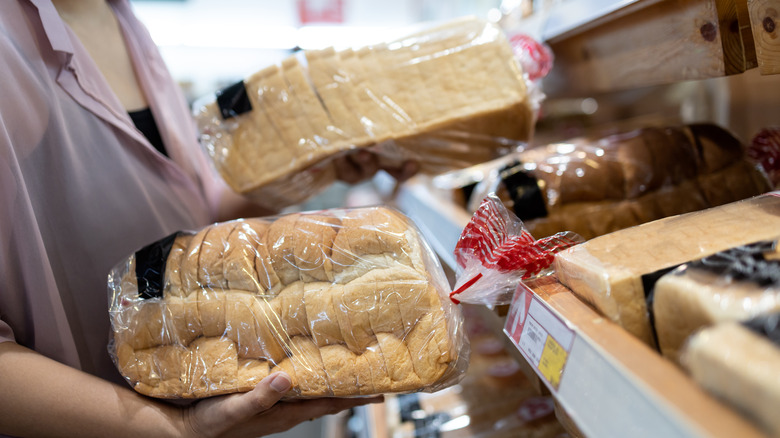What Happens If You Accidentally Eat Mold?
There are few things more disappointing than being in the mood for a simple slice of toast, then realizing your bread has been contaminated with specks of fuzzy green mold. Sometimes it's the whole loaf that's affected. Other times, it's only certain areas that you can easily cut off. But what if you're in a rush and only notice the mold after you've taken a bite? If you've ever eaten any sort of moldy food accidentally (or just took a risk that you now regret), don't fret. In most cases, it's not a big deal.
Your digestive and immune systems should have it all taken care of. As long as you're relatively healthy and don't have a mold allergy, the gastric acid in your stomach, along with your immune response, should keep you from getting ill. Any vomiting or nausea you might experience would be more likely to happen because of your personal disgust. Technically speaking, your body doesn't need to purge any ingested mold.
Don't take this as a go-ahead to chow down on fuzzy food, however. Mold is not 100 percent safe and, in certain cases, can make even healthy folks pretty sick. A kind of mold known as mycotoxins is even linked to cancer, says the World Health Organization. To be fair, these are usually only present in agricultural environments and hopefully not in your home kitchen. Still, if you want to be certain that you're safe, you'll be best off tossing that moldy food.
If you cut mold off food, is it safe to eat?
According to the USDA, most moldy foods are just too risky to eat. That applies when food is fully covered in mold and even when you can cut off the affected part. The only exceptions are long-lasting hard cheeses, cured meats, and certain fruits and vegetables. Fruits and vegetables with low moisture content and density, such as carrots or cabbage, can potentially be salvaged. Just make sure they haven't gone soft, then cut away the affected spot at least one inch around the mold. Be careful not to touch the mold with your knife, lest cross-contamination occur.
The same method applies to hard cheeses, too. With cured meat, however, it's okay to just scrub the fuzzy stuff off, as surface mold is a natural part of this product and should be safe. That said, any other type of food must be discarded whenever mold is present, as the risk of getting sick from contaminated foodstuffs is higher and simply isn't worth the risk to your health.
All told, it's best to just not go out of your way to consume moldy food of any kind. However, if it does happen by accident, know that it's not the worst thing in the world. Just remember to take a more careful look at your meal before you dig in next time.
Is all mold bad?
There are over 100,000 types of mold, but not all of them are the types you commonly find in food. If you see that tale-tell fuzziness on your meat or poultry, it's likely one of a dozen or so common types of mold like Botrytis, Geotrichum, Oidium, Penicillium, or Thamnidium.
It should be understood that if you see mold on the surface of any fresh meat, poultry, or seafood, the whole product should be disposed of immediately. As discussed above, though, the mere presence of mold is not necessarily a sign that food must be chucked. In addition to being able to safely scrub off mold that appears on the exterior of things like salami and hard cheese, there are some molds that are not just harmless, but an integral part of food production.
Mold from the Penicillium genus — yes, it's also what the antibiotic penicillin is derived from — helps give cheeses like Camembert, Brie, and Roquefort their distinct flavor and appearance. The molds in operation here don't behave differently than other molds, but the carefully-controlled conditions under which they are produced and developed don't allow for the molds to produce harmful mycotoxins.
How does mold get on your food?
Mold is all around you. More specifically, mold spores are all around you, but due to their microscopic size and inability to affect you, you never notice them. There are, though, molds that can have a profound effect on human health. Stachybotrys Atra is commonly referred to as black mold, and its presence in a home can spell trouble. Though not yet directly linked to any health problems, it is believed that black mold can cause breathing problems in those already predisposed to respiratory illness.
Mold finds its way onto your food much the same way black mold finds its way into parts of homes that are damp and hospitable. The spores by chance land on a piece of food that suits their needs. You, of course, won't notice at first, but soon a colony will form and sprout hyphae, the threadlike structures you see as mold's telltale fuzziness. While it isn't exactly a pleasant thought that our foods are constantly being bombarded by mold spores in search of a home, rest assured that it is an important part of the natural ballet that keeps the life cycle spinning.
Preventing mold at home
You can't entirely prevent mold from making its way onto your foods. Fruit, meat, cheese, and everything else you store away in your pantry, refrigerator, and freezer comes into contact with outside air. This happens in the natural growing environment, at production and packaging facilities, in transport, at the grocer, and in your home. Airtight packaging helps minimize exposure, but no form of packaging can fully eliminate it.
There are, however, steps you can take at home to lessen the threat of mold devouring your food before you've had a chance to consume it. First, all airtight containers should be left just as they are until you are ready to use the food inside. For produce that is sold fresh, unpackaged, or in packaging that is to some degree porous, it is helpful to shop for seasonal, locally-grown items in small quantities. This ensures freshness and reduces the amount of handling and damage done to produce in transit.
Additionally, keeping your kitchen, refrigerator, and food storage containers as clean as possible goes a long way in reducing the presence of mold spores. Temperature is also an important consideration as mold thrives in a warm moist environment. Isotherm bags and refrigeration are critical in slowing the spread of mold on food.
Food industry measures to combat mold
Food science is an expansive field with a variety of aims, one of which is preventing food spoilage by way of reducing microbial activity. Mechanical methods of food preservation that have been used for centuries included freezing, drying, and pasteurization, a process of rapid heating and cooling that halts some microbial activity. Additionally, irradiation and exposure to high pressure are more recent additions to the toolbox of food producers looking to extend the shelf-life of their goods. Packaging, while imperfect as discussed above, can offer some relief from mold. Wax paper impregnated with cinnamon oil, cellophane, and plant-based materials have all been shown to help reduce mold activity and transmission.
At the chemical level, a number of preservatives are employed to combat mold. If you've ever seen a loaf of fresh artisan bread get covered in mold, you know that baked goods and pastries are especially susceptible. Propionates, sorbates, benzoates, parabens, and acetic acid are the most common chemical additives applied to baked goods, and each has its advantages and drawbacks. Some, such as propionates, have little impact on the final product, whereas others, such as sorbates and benzoates, can inhibit the activity of yeast — another type of fungus — and fermentation, and are used more judiciously or have found use in foods other than baked goods, such as jams.
Although the food industry puts tremendous effort into preventing mold growth throughout production, it's impossible to completely eliminate the risk in the process just as you can't completely prevent it at home either. When some of your food inevitably grows an unwelcome fungal friend, just know not all mold is bad, and it can be cut away from certain foods and safely eaten — for everything else there's always the trash bin.
